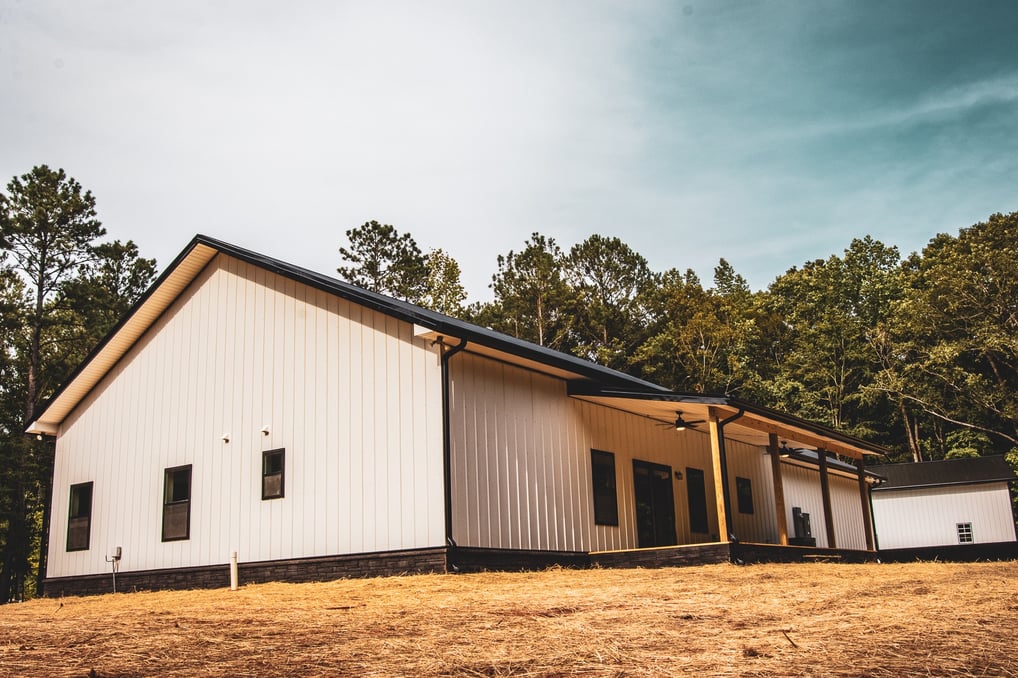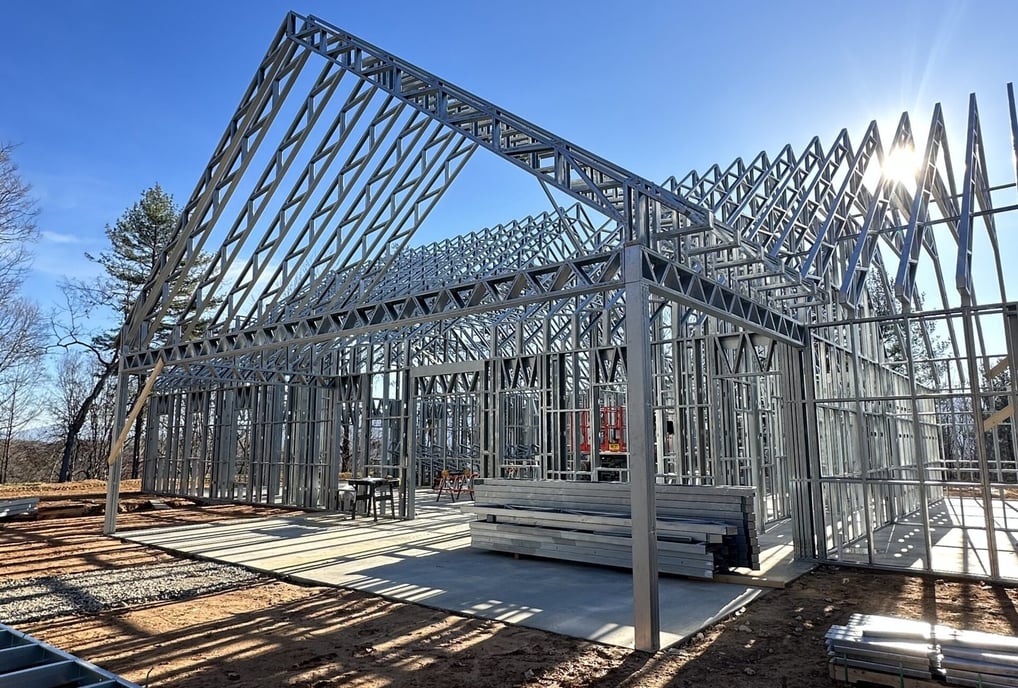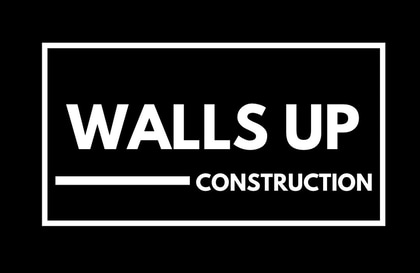No matter the size, shape, or complexity of your project; Walls Up Construction has the experience and capability to get it done right. We offer two framing options to choose from for your custom build. Our standard option is built with wood post framing. Our premium option is built with cold form steel framing with a 50 year structural warranty. Both options will be engineered to you local codes and built to last generations.


Post Frame
Wood is a timeless building material, and Post Frame buildings are indeed timeless. First of all, building packages use large, solid-sawn posts or laminated wall columns to add lasting strength to the structure. Next, posts are attached to concrete to handle heavy weight loads Another load-bearing component is the pre-manufactured truss, which supports roof loads by carrying the load to the foundation. Finally, exterior sheathing creates lateral load resistance, making the building strong and solid. Combining quality materials with tried and true building practices, Post Frame Buildings are an option to consider for your next building project.
VERSATILE FOR YOUR NEEDS
Long-span trusses allow for larger open floor plans without the need for interior load–bearing walls, providing more design options. We design your building for whatever you need, from a small garage to a large barn.
Traditional Post Frame construction designed with modern engineering ensures code compliance and durability.
A wide variety of building designs are available in a variety of colors.
We use only high-grade lumber for our buildings to assure long life for your new building.
EFFICIENCY
A post-frame building has thicker wall cavities than steel-frame buildings, creating a larger space for insulation and controlling energy costs 12 months out of the year. In the places where the insulation is interrupted – triple-laminated columns – post-frame buildings have natural insulating properties and conduct less heat than most steel-frame buildings.
Additionally, post-frame buildings include an attic, allowing for more effective ceiling insulation, enhanced air circulation and condensation control. In a standard steel-frame building, insulation is draped over roof purlins and compressed when the roofing is applied, resulting in the loss of nearly half of the thickness of the insulation.


Cold-Formed Steel Buildings
Cold-formed steel (CFS) has been a staple of the construction industry for more than a century, and it’s easy to see why. Steel, in general, is a highly durable material. And when it’s formed using cold-form processes, it becomes even stronger. CFS offers cost-effective, durable, eco-friendly building options that are in high demand today as inflation and supply chain woes drive prices up, and sustainability is a top priority for many industries.
Let’s take a look at the advantages of choosing cold-formed steel over other building materials.
CFS is a Cost-Effective Building Material
Even if you’re working with a comfortable budget, money is always a factor in choosing building materials. Cold-formed steel is a truly cost-effective material choice, offering layers of savings with lower labor costs, lower material costs, and easy scalability. Many contractors choose CFS to save money upfront, lowering the cost to build, and many stakeholders choose CFS for long-term savings with fewer maintenance needs.
Here is how you can lower your costs using CFS:
High Strength-to-Weight Ratio Means Fewer Materials Needed
Panelization Reduces On-Site Construction Costs
Shorter Product Cycles Means You’re Productive in Less Time
Lower Insurance Premiums Due to Weather & Fire Safety Ratings
Fewer Site Safety-Related Costs Like Security or Inspections
Fewer Long-Term Maintenance Needs Due to Durability
A lower up-front price tag is just the beginning of cost savings with a cold-formed steel building. This material is versatile and scalable, and lends itself well to commercialization–meaning that it is easily mass-produced to bring efficiency and cost savings to the construction process. So, in a nutshell, CFS is a cost-effective building material from beginning to end.
Cold-Formed Steel is More Durable
Next to money, durability is the second most important factor when choosing materials. Steel has a well-known reputation for its strength. But what many building owners might not realize is that cold-formed steel is particularly strong. The manufacturing processes performed at a lower heat produce compressed sheets that offer improved durability over hot-formed steel sheets.
Add to the sheer strength of CFS that steel is also impervious to most environmental factors like pests, moisture, heat, and wind. Using CFS, you’ll incur far fewer long-term maintenance costs typically caused by environmental exposure.
It’s a Sustainable Choice
Steel is a 100% recyclable material. Often, CFS panels used in new construction are from recycled materials. Plus, when the building is removed or renovated, the steel components will still be 100% recyclable.
Using CFS as a sustainable building material is a choice that you can feel good about. The CFS manufacturing process is inherently designed to eliminate waste. It’s based on a dry system that does not require excessive water consumption to produce heat or cool the steel. If you’re looking for an eco-friendly material choice, CFS is green from beginning to end.
Cold-Formed Steel is a Safer Building Material
When it comes to safety, you may not realize the role that individual building materials play. It’s true–choosing highly combustible framing materials like timber or untreated wood paneling for walls and roofing increases the combustibility of the entire building. That means, in the event of a fire, the building turns into a tinder box and is quickly engulfed in flames.
With CFS, your building’s occupants may have more time to reach safety. While many of the accompanying building materials will still burn, the structure of a CFS building is non-combustible, which considerably slows the spread of the fire. From goodwill to a good price, cold-formed steel is a good choice for your next building project.
The non-combustible nature of CFS means:
Buildings are Safer for Human Occupants
In the Event of a Fire, the Impact on Municipal Fire Services is Reduced
Buildings Cost Less to Insure
In fact, did you know that the melting point of steel is approximately 2,700 degrees Fahrenheit? The average building fire only reaches 1,000 degrees Fahrenheit, and even the hottest fires rarely exceed 1,800 degrees, so CFS will remain non-combustible from construction through destruction.
CFS is Easy to Install
If money, safety, and sustainability aren’t enough to inform your decision, consider the construction process. Cold-formed steel is well-known for being easy to install. This means you’ll have fewer labor hours invested in the construction of your building, leading to both lower costs and a quicker build. If your goal is to get through construction quickly, cold-formed steel is the right choice.
Cold-formed steel is so versatile that it can even be installed during the coldest months of the year. This means that you won’t be limited to summer months to construct your building, and you won’t have to plan for portable heaters during construction. These buildings are often panelized, leading to easy construction in less time compared to other building materials. And all of these benefits are just what you’ll see day-to-day with CFS.
It’s Resistant to Extreme Weather Conditions
How often do you face extreme weather like tropical storms, intense blizzards, or tornadoes? Cold-formed steel, notable for its durability, is the best choice for buildings constructed in areas that experience extreme weather.
According to the Steel Framing Industry Association, CFS is a truly weather-resilient building material. This designation goes beyond durability, encompassing safety, security, durability, energy conservation, and the general ability to be resourceful during an extreme weather event. To that end, cold-formed steel is a superior building material offering the structural resilience that your business needs to remain operational in the face of catastrophic weather conditions


